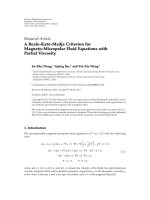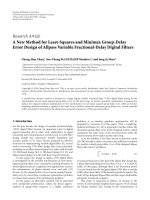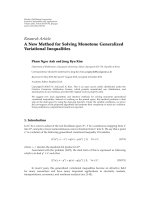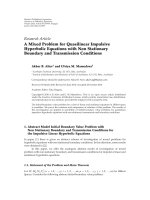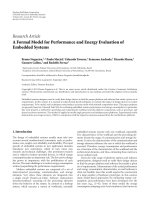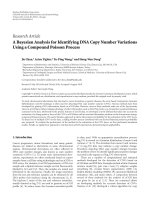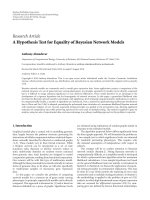Báo cáo hóa học: " Research Article A Beale-Kato-Madja Criterion for " ppt
Bạn đang xem bản rút gọn của tài liệu. Xem và tải ngay bản đầy đủ của tài liệu tại đây (518.21 KB, 14 trang )
Hindawi Publishing Corporation
Boundary Value Problems
Volume 2011, Article ID 128614, 14 pages
doi:10.1155/2011/128614
Research Article
A Beale-Kato-Madja Criterion for
Magneto-Micropolar Fluid Equations with
Partial Viscosity
Yu-Zhu Wang,
1
Liping Hu,
2
and Yin-Xia Wang
1
1
School of Mathematics and Information Sciences, North China University of Water Resources and
Electric Power, Zhengzhou 450011, China
2
College of Information and Management Science, Henan Agricultural University,
Zhengzhou 450002, China
Correspondence should be addressed to Yu-Zhu Wang,
Received 18 February 2011; Accepted 7 March 2011
Academic Editor: Gary Lieberman
Copyright q 2011 Yu-Zhu Wang et al. This is an open access article distributed under the Creative
Commons Attribution License, which permits unrestricted use, distribution, and reproduction in
any medium, provided the original work is properly cited.
We study the incompressible magneto-micropolar fluid equations with partial viscosity in
R
n
n
2, 3. A blow-up criterion of smooth solutions is obtained. The result is analogous to the celebrated
Beale-Kato-Majda type criterion for the inviscid Euler equations of incompressible fluids.
1. Introduction
The incompressible magneto-micropolar fluid equations in R
n
n 2, 3 take the following
form:
∂
t
u −
μ χ
Δu u ·∇u − b ·∇b ∇
p
1
2
|
b
|
2
− χ∇×v 0,
∂
t
v − γΔv − κ∇ div v 2χv u ·∇v − χ∇×u 0,
∂
t
b − νΔb u ·∇b − b ·∇u 0,
∇·u 0, ∇·b 0,
1.1
where ut, x, vt, x, bt, x and pt, x denote the velocity of the fluid, the microrotational
velocity, magnetic field, and hydrostatic pressure, respectively. μ is the kinematic viscosity, χ
is the vortex viscosity, γ and κ are spin viscosities, and 1/ν is the magnetic Reynold.
2 Boundary Value Problems
The incompressible magneto-micropolar fluid equation 1.1 has been studied
extensively see 1–7.In2, the authors have proven that a weak solution to 1.1 has
fractional time derivatives of any order less than 1/2 in the two-dimensional case. In the
three-dimensional case, a uniqueness result similar to the one for Navier-Stokes equations is
given and the same result concerning fractional derivatives is obtained, but only for a more
regular weak solution. Rojas-Medar 4 established local existence and uniqueness of strong
solutions by the Galerkin method. Rojas-Medar and Boldrini 5 also proved the existence
of weak solutions by the Galerkin method, and in 2D case, also proved the uniqueness of
the weak solutions. Ortega-Torres and Rojas-Medar 3 proved global existence of strong
solutions for small initial data. A Beale-Kato-Majda type blow-up criterion for smooth
solution u, v, b to 1.1 that relies on the vorticity of velocity ∇×u only is obtained by
Yuan 7. For regularity results, refer to Yuan 6 and Gala 1.
If b 0, 1.1 reduces to micropolar fluid equations. The micropolar fluid equations
was first developed by Eringen 8. It is a type of fluids which exhibits the microrotational
effects and microrotational inertia, and can be viewed as a non-Newtonian fluid. Physically,
micropolar fluid may represent fluids consisting of rigid, randomly oriented or spherical
particles suspended in a viscous medium, where the deformation of fluid particles is
ignored. It can describe many phenomena that appeared in a large number of complex fluids
such as the suspensions, animal blood, and liquid crystals which cannot be characterized
appropriately by the Navier-Stokes equations, and that it is important to the scientists
working with the hydrodynamic-fluid problems and phenomena. For more background, we
refer to 9 and references therein. The existences of weak and strong solutions for micropolar
fluid equations were proved by G aldi and Rionero
10 and Yamaguchi 11, respectively.
Regularity criteria of weak solutions to the micropolar fluid equations are investigated in
12.In13, the authors gave sufficient conditions on the kinematics pressure in order to
obtain regularity and uniqueness of t he weak solutions to the micropolar fluid equations.
The convergence of weak solutions of the micropolar fluids in bounded domains of R
n
was
investigated see 14. When the viscosities tend to zero, in t he limit, a fluid governed by an
Euler-like system was found.
If both v 0andχ 0, then 1.1 reduces to be the magneto-hydrodynamic
MHD equations. There are numerous important progresses on the fundamental issue of the
regularity for the weak solution to MHD systems see 15–23.Zhou18 established Serrin-
type regularity criteria in term of the velocity only. Logarithmically improved regularity
criteria for MHD equations were established in 16, 23. Regularity criteria for the 3D
MHD equations in term of the pressure were obtained 19. Zhou and Gala 20 obtained
regularity criteria of solutions in term of u and ∇×u in the multiplier spaces. A new
regularity criterion for weak solutions to the viscous MHD equations in terms of the vorticity
field in Morrey-Campanato spaces was established see 21.In22, a regularity criterion
∇b ∈ L
1
0,T;BMOR
2
for the 2D MHD system with zero magnetic diffusivity was
obtained.
Regularity criteria for the generalized viscous MHD equations were also obtained in
24. Logarithmically improved regularity criteria for two related models to MHD equations
were established in 25 and 26, respectively. Lei and Zhou 27 studied the magneto-
hydrodynamic equations with v 0andμ χ 0. Caflisch et al. 28 and Zhang
and Liu 29 obtained blow-up criteria of smooth solutions to 3-D ideal MHD equations,
respectively. Cannone et al. 30 showed a losing estimate for the ideal MHD equations and
applied it to establish an improved blow-up criterion of smooth solutions to ideal MHD
equations.
Boundary Value Problems 3
In this paper, we consider the magneto-micropolar fluid equations 1.1 with partial
viscosity, that is, μ χ 0. Without loss of generality, we take γ κ ν 1. The
corresponding magneto-micropolar fluid equations thus reads
∂
t
u u ·∇u − b ·∇b ∇
p
1
2
|
b
|
2
0,
∂
t
v − Δv −∇div v u ·∇v 0,
∂
t
b − Δb u ·∇b − b ·∇u 0,
∇·u 0, ∇·b 0.
1.2
In the absence of global well-posedness, the development of blow-up/non blow-up
theory is of major importance for both theoretical and practical purposes. For incompressible
Euler and Navier-Stokes equations, the well-known Beale-Kato-Majda’s criterion 31 says
that any solution u is smooth up to time T under the assumption that
T
0
∇ × ut
L
∞
dt <
∞. Beale-Kato-Majdas criterion is slightly improved by Kozono and Taniuchi 32 under the
assumption
T
0
∇ × ut
BMO
dt < ∞. In this paper, we obtain a Beale-Kato-Majda type blow-
up criterion of smooth solutions to the magneto-micropolar fluid equations 1.2.
Now we state our results as follows.
Theorem 1.1. Let u
0
,v
0
,b
0
∈ H
m
R
n
n 2, 3, m ≥ 3 with ∇·u
0
0, ∇·b
0
0. Assume that
u, v, b is a smooth solution to 1.2 with initial data u0,xu
0
x, v0,xv
0
x, b0,x
b
0
x for 0 ≤ t<T.Ifu satisfies
T
0
∇×ut
BMO
ln
e
∇×u
t
BMO
dt < ∞, 1.3
then the solution u, v, b can be extended beyond t T.
We have the following corollary immediately.
Corollary 1.2. Let u
0
,v
0
,b
0
∈ H
m
R
n
n 2, 3, m ≥ 3 with ∇·u
0
0, ∇·b
0
0. Assume that
u, v, b is a smooth solution to 1.2 with initial data u0,xu
0
x, v0,xv
0
x, b0,x
b
0
x for 0 ≤ t<T. Suppose that T is the maximal existence time, then
T
0
∇×ut
BMO
ln
e
∇×u
t
BMO
dt ∞. 1.4
The paper is organized as follows. We first state some preliminaries on functional
settings and some important inequalities in Section 2 and then prove the blow-up criterion of
smooth solutions to the magneto-micropolar fluid equations 1.2 in Section 3.
4 Boundary Value Problems
2. Preliminaries
Let SR
n
be the Schwartz class of rapidly decreasing functions. Given f ∈SR
n
, its Fourier
transform Ff
f is defined by
f
ξ
R
n
e
−ix·ξ
f
x
dx 2.1
and for any given g ∈SR
n
, its inverse Fourier transform F
−1
g ˇg is defined by
ˇg
x
R
n
e
ix·ξ
g
ξ
dξ. 2.2
Next, let us recall the Littlewood-Paley decomposition. Choose a nonnegative radial
functions φ ∈SR
n
, supported in C {ξ ∈ R
n
: 3/4 ≤|ξ|≤8/3} such that
∞
k−∞
φ
2
−k
ξ
1, ∀ξ ∈ R
n
\
{
0
}
. 2.3
The frequency localization operator is defined by
Δ
k
f
R
n
ˇ
φ
y
f
x − 2
−k
y
dy. 2.4
Let us now define homogeneous function spaces see e.g., 33, 34. For p, q ∈ 1, ∞
2
and s ∈ R, t he homogeneous Triebel-Lizorkin space
˙
F
s
p,q
as the set of tempered distributions
f such that
f
˙
F
s
p,q
k∈Z
2
sqk
Δ
k
f
q
1/q
L
p
< ∞. 2.5
BMO denotes the homogenous space of bounded mean oscillations associated with the norm
f
BMO
sup
x∈R
n
,R>0
1
|
B
R
x
|
B
R
x
f
y
−
1
B
R
y
B
R
y
f
z
dz
dy. 2.6
Thereafter, we will use the fact BMO
˙
F
0
∞,2
.
In what follows, we will make continuous use of Bernstein inequalities, which comes
from 35.
Boundary Value Problems 5
Lemma 2.1. For any s ∈ N, 1 ≤ p ≤ q ≤∞and f ∈ L
p
R
n
,then
c2
km
Δ
k
f
L
p
≤
∇
m
Δ
k
f
L
p
≤ C2
km
Δ
k
f
L
p
,
Δ
k
f
L
q
≤ C2
n1/p−1/qk
Δ
k
f
L
p
2.7
hold, where c and C are positive constants independent of f and k.
The following inequality is well-known Gagliardo-Nirenberg inequality.
Lemma 2.2. There exists a uniform positive constant C>0 such that
∇
i
u
L
2m/i
≤ C
u
1−i/m
L
∞
∇
m
u
i/m
L
2
, 0 ≤ i ≤ m 2.8
holds for all u ∈ L
∞
R
n
∩ H
m
R
n
.
The following lemma comes from 36.
Lemma 2.3. The following calculus inequality holds:
∇
m
u ·∇v − u ·∇∇
m
v
L
2
≤ C
∇u
L
∞
∇
m
v
L
2
∇v
L
∞
∇
m
u
L
2
. 2.9
Lemma 2.4. There is a uniform positive constant C, such that
∇u
L
∞
≤ C
1
u
L
2
∇×u
BMO
ln
e
u
H
3
2.10
holds for all vectors u ∈ H
3
R
n
n 2, 3 with ∇·u 0.
Proof. The proof can be found in 37. For completeness, the proof will be also sketched here.
It follows from Littlewood-Paley decomposition that
∇u
0
k−∞
Δ
k
∇u
A
k1
Δ
k
∇u
∞
kA1
Δ
k
∇u. 2.11
Using 2.7 and 2.11,weobtain
∇u
L
∞
≤
0
k−∞
Δ
k
∇u
L
∞
A
k1
Δ
k
∇u
L
∞
∞
kA1
Δ
k
∇u
L
∞
≤ C
0
k−∞
2
1n/2k
Δ
k
u
L
2
A
1/2
A
k1
|
Δ
k
∇u
|
2
1/2
L
∞
∞
kA1
2
−2−n/2k
Δ
k
∇
3
u
L
2
≤ C
u
L
2
A
1/2
∇u
BMO
2
−2−n/2A
∇
3
u
L
2
.
2.12
6 Boundary Value Problems
By the Biot-Savard law, we have a representation of ∇u in terms of ∇×u as
u
x
j
R
j
R ×∇u
,j 1, 2, ,n. 2.13
where R R
1
, ,R
n
, R
j
∂/∂x
j
−Δ
−1/2
denote the Riesz transforms. Since R is a
bounded operator in BMO, this yields
∇u
BMO
≤ C
∇×u
BMO
2.14
with C Cn. Taking
A
1
2 − n/2
ln 2
ln
e
u
H
3
1. 2.15
It follows from 2.12, 2.14,and2.15 that 2.10 holds. Thus, the lemma is proved.
In order to prove Theorem 1.1, we need the following interpolation inequalities in two
and three space dimensions.
Lemma 2.5. In three s pace dimensions, the following inequalities
∇u
L
2
≤ C
u
2/3
L
2
∇
3
u
1/3
L
2
,
u
L
∞
≤ C
u
1/4
L
2
∇
2
u
3/4
L
2
,
u
L
4
≤ C
u
3/4
L
2
∇
3
u
1/4
L
2
2.16
hold, and in two space dimensions, the following inequalities
∇u
L
2
≤ C
u
2/3
L
2
∇
3
u
1/3
L
2
,
u
L
∞
≤ C
u
1/2
L
2
∇
2
u
1/2
L
2
,
u
L
4
≤ C
u
5/6
L
2
∇
3
u
1/6
L
2
2.17
hold.
Proof. 2.16 and 2.17 are of course well known. In fact, we can obtain them by Sobolev
embedding and the scaling techniques. In what follows, we only prove the last inequality
in 2.16 and 2.17. Sobolev embedding implies that H
3
R
n
→ L
4
R
n
for n 2, 3.
Consequently, we get
u
L
4
≤ C
u
L
2
∇
3
u
L
2
. 2.18
Boundary Value Problems 7
For any given 0
/
u ∈ H
3
R
n
and δ>0, let
u
δ
x
u
δx
. 2.19
By 2.18 and 2.19,weobtain
u
δ
L
4
≤ C
u
δ
L
2
∇
3
u
δ
L
2
, 2.20
which is equivalent to
u
L
4
≤ C
δ
−n/4
u
L
2
δ
3−n/4
∇
3
u
L
2
. 2.21
Taking δ u
1/3
L
2
∇
3
u
−1/3
L
2
and n 3andn 2, respectively. From 2.21, we immediately
get the last inequality in 2.16 and 2.17. Thus, we have completed the proof of Lemma
2.5.
3. Proof of Main Results
Proof of Theorem 1.1. Multiplying 1.2 by u, v, b, respectively, then integrating the resulting
equation with respect to x on R
n
and using integration by parts, we get
1
2
d
dt
u
t
2
L
2
v
t
2
L
2
b
t
2
L
2
∇vt
2
L
2
div vt
2
L
2
∇bt
2
L
2
0, 3.1
where we have used ∇·u 0and∇·b 0.
Integrating with respect to t,weobtain
ut
2
L
2
vt
2
L
2
bt
2
L
2
2
t
0
∇vτ
2
L
2
dτ 2
t
0
div vτ
2
L
2
dτ
2
t
0
∇bτ
2
L
2
dτ
u
0
2
L
2
v
0
2
L
2
b
0
2
L
2
.
3.2
Applying ∇ to 1.2 and taking the L
2
inner product of the resulting equation with
∇u, ∇v,∇b, with help of integration by parts, we have
1
2
d
dt
∇u
t
2
L
2
∇v
t
2
L
2
∇b
t
2
L
2
∇
2
vt
2
L
2
div ∇vt
2
L
2
∇
2
bt
2
L
2
−
R
n
∇
u ·∇u
∇udx
R
n
∇
b ·∇b
∇udx−
R
n
∇
u ·∇v
∇vdx
−
R
n
∇
u ·∇b
∇bdx
R
n
∇
b ·∇u
∇bdx.
3.3
8 Boundary Value Problems
It follows from 3.3 and ∇·u 0, ∇·b 0that
1
2
d
dt
∇u
t
2
L
2
∇v
t
2
L
2
∇b
t
2
L
2
∇
2
v
t
2
L
2
div ∇v
t
2
L
2
∇
2
b
t
2
L
2
≤ 3
∇u
t
L
∞
∇u
t
2
L
2
∇v
t
2
L
2
∇b
t
2
L
2
.
3.4
By Gronwall inequality, we get
∇ut
2
L
2
∇vt
2
L
2
∇bt
2
L
2
2
t
t
1
∇
2
vτ
2
L
2
dτ
2
t
t
1
div ∇v
τ
2
L
2
dτ 2
t
t
1
∇
2
bτ
2
L
2
dτ
≤
∇u
t
1
2
L
2
∇v
t
1
2
L
2
∇b
t
1
2
L
2
exp
C
t
t
1
∇u
τ
L
∞
dτ
.
3.5
Thanks to 1.3, we know that for any small constant ε>0, there exists T
<Tsuch
that
T
T
∇×ut
BMO
ln
e
∇×ut
BMO
dt ≤ ε. 3.6
Let
A
t
sup
T
≤τ≤t
∇
3
u
τ
2
L
2
∇
3
v
τ
2
L
2
∇
3
b
τ
2
L
2
,T
≤ t<T. 3.7
It follows from 3.5, 3.6, 3.7,andLemma 2.4 that
∇ut
2
L
2
∇vt
2
L
2
∇bt
2
L
2
2
t
T
∇
2
vτ
2
L
2
dτ
2
t
T
div ∇vτ
2
L
2
dτ 2
t
T
∇
2
bτ
2
L
2
dτ
≤ C
1
exp
C
0
t
T
∇×u
BMO
ln
e
u
H
3
dτ
≤ C
1
exp
{
C
0
ε ln
e A
t
}
≤ C
1
e A
t
C
0
ε
,T
≤ t<T,
3.8
where C
1
depends on ∇uT
2
L
2
∇vT
2
L
2
∇bT
2
L
2
, while C
0
is an absolute positive
constant.
Boundary Value Problems 9
Applying ∇
m
to the first equation of 1.2, then taking L
2
inner product of the resulting
equation with ∇
m
u, using integration by parts, we get
1
2
d
dt
∇
m
ut
2
L
2
−
R
n
∇
m
u ·∇u
∇
m
udx
R
n
∇
m
b ·∇b
∇
m
udx. 3.9
Similarly, we obtain
1
2
d
dt
∇
m
vt
2
L
2
∇
m
∇vt
2
L
2
div ∇
m
vt
2
L
2
−
R
n
∇
m
u ·∇v
∇
m
vdx,
1
2
d
dt
∇
m
b
t
2
L
2
∇
m
∇bt
2
L
2
−
R
n
∇
m
u ·∇b
∇
m
bdx
R
n
∇
m
b ·∇u
∇
m
bdx.
3.10
Using 3.9, 3.10, ∇·u 0, ∇·b 0, and integration by parts, we have
1
2
d
dt
∇
m
u
t
2
L
2
∇
m
v
t
2
L
2
∇
m
b
t
2
L
2
∇
m
∇vt
2
L
2
div ∇
m
vt
2
L
2
∇
m
∇bt
2
L
2
−
R
n
∇
m
u ·∇u
−u ·∇∇
m
u
∇
m
udx
R
n
∇
m
b ·∇b
−b ·∇∇
m
b
∇
m
udx
−
R
n
∇
m
u ·∇v
−u ·∇∇
m
v
∇
m
vdx−
R
n
∇
m
u ·∇b
−u ·∇∇
m
b
∇
m
bdx
R
n
∇
m
b ·∇u
− b ·∇∇
m
u
∇
m
bdx.
3.11
In what follows, for simplicity, we will set m 3.
From H
¨
older inequality and Lemma 2.3,weget
−
R
n
∇
3
u ·∇u
− u ·∇∇
3
u
∇
3
udx
≤ C
∇u
t
L
∞
∇
3
ut
2
L
2
. 3.12
Using integration by parts and H
¨
older inequality, we obtain
−
R
n
∇
3
u ·∇v
− u ·∇∇
3
v
∇
3
vdx
≤ 7
∇u
t
L
∞
∇
3
vt
2
L
2
4
∇ut
L
∞
∇
2
vt
L
2
∇
4
vt
L
2
∇
2
ut
L
4
∇vt
L
4
∇
4
vt
L
2
.
3.13
10 Boundary Value Problems
By Lemma 2.5, Young inequality, and 3.8, we deduce that
4
∇ut
L
∞
∇
2
vt
L
2
∇
4
vt
L
2
≤ C
∇u
t
L
∞
∇v
t
2/3
L
2
∇
4
vt
4/3
L
2
≤
1
4
∇
4
vt
2
L
2
C
∇ut
3
L
∞
∇vt
2
L
2
≤
1
4
∇
4
vt
2
L
2
C
∇ut
L
∞
∇ut
1/2
L
2
∇
3
ut
3/2
L
2
∇vt
2
L
2
≤
1
4
∇
4
v
t
2
L
2
C
∇u
t
L
∞
e A
t
5/4C
0
ε
A
3/4
t
3.14
in 3D and
4
∇ut
L
∞
∇
2
vt
L
2
∇
4
vt
L
2
≤ C
∇ut
L
∞
∇vt
2/3
L
2
∇
4
vt
4/3
L
2
≤
1
4
∇
4
vt
2
L
2
C
∇ut
3
L
∞
∇vt
2
L
2
≤
1
4
∇
4
vt
2
L
2
C
∇ut
L
∞
∇ut
L
2
∇
3
u
t
L
2
∇vt
2
L
2
≤
1
4
∇
4
vt
2
L
2
C
∇u
t
L
∞
e A
t
3/2C
0
ε
A
1/2
t
3.15
in 2D.
From Lemmas 2.2 and 2.5, Young inequality, and 3.8, we have
∇
2
ut
L
4
∇vt
L
4
∇
4
vt
L
2
≤ C
∇ut
1/2
L
∞
∇
3
ut
1/2
L
2
∇vt
3/4
L
2
∇
4
vt
5/4
L
2
≤
1
4
∇
4
vt
2
L
2
C
∇ut
4/3
L
∞
∇
3
ut
4/3
L
2
∇vt
2
L
2
≤
1
4
∇
4
vt
2
L
2
C
∇ut
L
∞
∇ut
1/12
L
2
∇
3
ut
19/12
L
2
∇vt
2
L
2
≤
1
4
∇
4
vt
2
L
2
C
∇ut
L
∞
e A
t
25/24C
0
ε
A
19/24
t
3.16
Boundary Value Problems 11
in 3D and
∇
2
ut
L
4
∇vt
L
4
∇
4
vt
L
2
≤ C
∇ut
1/2
L
∞
∇
3
ut
1/2
L
2
∇vt
5/6
L
2
∇
4
vt
7/6
L
2
≤
1
4
∇
4
vt
2
L
2
C
∇ut
6/5
L
∞
∇
3
ut
6/5
L
2
∇vt
2
L
2
≤
1
4
∇
4
vt
2
L
2
C
∇ut
L
∞
∇ut
1/10
L
2
∇
3
ut
13/10
L
2
∇vt
2
L
2
≤
1
4
∇
4
vt
2
L
2
C
∇ut
L
∞
e A
t
21/20C
0
ε
A
13/20
t
3.17
in 2D.
Consequently, we get
4
∇ut
L
∞
∇
2
vt
L
2
∇
4
vt
L
2
≤
1
4
∇
4
v
t
2
L
2
C
∇u
t
L
∞
e A
t
,
∇
2
ut
L
4
∇vt
L
4
∇
4
vt
L
2
≤
1
4
∇
4
vt
2
L
2
C
∇u
t
L
∞
e A
t
3.18
provided that
ε ≤
1
5C
0
. 3.19
It follows from 3.13 and 3.18 that
−
R
n
∇
3
u ·∇v
− u ·∇∇
3
v
∇
3
vdx
≤
1
2
∇
4
vt
2
L
2
C
∇u
t
L
∞
e A
t
.
3.20
12 Boundary Value Problems
Similarly, we obtain
−
R
n
∇
3
u ·∇b
− u ·∇∇
3
b
∇
3
bdx
≤
1
6
∇
4
bt
2
L
2
C
∇u
t
L
∞
e A
t
,
R
n
∇
3
b ·∇b
− b ·∇∇
3
b
∇
3
udx
≤
1
6
∇
4
b
t
2
L
2
C
∇u
t
L
∞
e A
t
,
R
n
∇
3
b ·∇u
− b ·∇∇
3
u
∇
3
bdx
≤
1
6
∇
4
bt
2
L
2
C
∇u
t
L
∞
e A
t
.
3.21
Combining 3.11, 3.12, 3.20,and3.21 yields
d
dt
∇
3
u
t
2
L
2
∇
3
v
t
2
L
2
∇
3
b
t
2
L
2
∇
4
vt
2
L
2
div ∇
3
vt
2
L
2
∇
4
b
t
2
L
2
≤ C
∇u
t
L
∞
e A
t
3.22
for all T
≤ t<T.
Integrating 3.22 with respect to t from T
to τ and using Lemma 2.4, we have
e
∇
3
uτ
2
L
2
∇
3
vτ
2
L
2
∇
3
bτ
2
L
2
≤ e
∇
3
uT
2
L
2
∇
3
vT
2
L
2
∇
3
bT
2
L
2
C
2
τ
T
1
u
L
2
∇×u
s
BMO
ln
e A
s
e A
s
ds,
3.23
which implies
e A
t
≤ e
∇
3
u
T
2
L
2
∇
3
v
T
2
L
2
∇
3
b
T
2
L
2
C
2
t
T
1
u
L
2
∇×u
τ
BMO
ln
e A
τ
e A
τ
dτ.
3.24
Boundary Value Problems 13
For all T
≤ t<T, from Gronwall inequality and 3.24,weobtain
e
∇
3
ut
2
L
2
∇
3
vt
2
L
2
∇
3
bt
2
L
2
≤ C, 3.25
where C depends on ∇uT
2
L
2
∇vT
2
L
2
∇bT
2
L
2
.
Noting that 3.2 and the right hand side of 3.25 is independent of t for T
≤ t<T,
we know that uT, ·,vT, ·,bT, · ∈ H
3
R
n
.Thus,Theorem 1.1 is proved.
Acknowledgment
This work was supported by the NNSF of China Grant no. 10971190.
References
1 S. Gala, “Regularity criteria for the 3D magneto-micropolar fluid equations in the Morrey-Campanato
space,” Nonlinear Differential Equations and Applications, vol. 17, no. 2, pp. 181–194, 2010.
2 E. E. Ortega-Torres and M. A. Rojas-Medar, “On the uniqueness and regularity of the weak solution
for magneto-micropolar fluid equations,” Revista de Matem
´
aticas Aplicadas, vol. 17, no. 2, pp. 75–90,
1996.
3 E. E. Ortega-Torres and M. A. Rojas-Medar, “Magneto-micropolar fluid motion: global existence of
strong solutions,” Abstract and Applied Analysis, vol. 4, no. 2, pp. 109–125, 1999.
4 M. A. Rojas-Medar, “Magneto-micropolar fluid motion: existence and uniqueness of strong solution,”
Mathematische Nachrichten, vol. 188, pp. 301–319, 1997.
5 M. A. Rojas-Medar and J. L. Boldrini, “Magneto-micropolar fluid motion: existence of weak
solutions,” Revista Matem
´
atica Complutense, vol. 11, no. 2, pp. 443–460, 1998.
6 B. Q. Yuan, “Regularity of weak solutions to magneto-micropolar fluid equations,” Acta Mathematica
Scientia, vol. 30, no. 5, pp. 1469–1480, 2010.
7 J. Yuan, “Existence theorem and blow-up criterion of the strong solutions to the magneto-micropolar
fluid equations,” Mathematical Methods in the Applied Sciences, vol. 31, no. 9, pp. 1113–1130, 2008.
8 A. C. Eringen, “Theory of micropolar fluids,” Journal of Mathematics and Mechanics, vol. 16, pp. 1–18,
1966.
9 G. Łukaszewicz, Micropolar Fluids. Theory and Applications, Modeling and Simulation in Science,
Engineering and Technology, Birkh
¨
auser, Boston, Mass, USA, 1999.
10 G. P. Galdi and S. Rionero, “A note on the existence and uniqueness of solutions of the micropolar
fluid equations,” International Journal of Engineering Science, vol. 15, no. 2, pp. 105–108, 1977.
11 N. Yamaguchi, “Existence of global strong solution to the micropolar fluid system in a bounded
domain,” Mathematical Methods in the Applied Sciences, vol. 28, no. 13, pp. 1507–1526, 2005.
12 B Q. Dong and Z M. Chen, “Regularity criteria of weak solutions to the three-dimensional
micropolar flows,” Journal of Mathematical Physics, vol. 50, no. 10, article 103525, p. 13, 2009.
13 E. Ortega-Torres and M. Rojas-Medar, “On the regularity for solutions of the micropolar fluid
equations,” Rendiconti del Seminario Matematico della Universit
`
a di Padova, vol. 122, pp. 27–37, 2009.
14 E. Ortega-Torres, E. J. Villamizar-Roa, and M. A. Rojas-Medar, “Micropolar fluids with vanishing
viscosity,” Abstract and Applied Analysis, vol. 2010, Article ID 843692, 18 pages, 2010.
15 C. Cao and J. Wu, “Two regularity criteria for the 3D MHD equations,” Journal of Differential Equations,
vol. 248, no. 9, pp. 2263–2274, 2010.
16 J. Fan, S. Jiang, G. Nakamura, and Y. Zhou, “Logarithmically improved regularity criteria for the
Navier-Stokes and MHD equations,” Journal of Mathematical Fluid Mechanics. In press.
17 C. He and Z. Xin, “Partial regularity of suitable weak solutions to the incompressible magnetohydro-
dynamic equations,” Journal of Functional Analysis, vol. 227, no. 1, pp. 113–152, 2005.
18 Y. Zhou, “Remarks on regularities for the 3D MHD equations,” Discrete and Continuous Dynamical
Systems. Series A, vol. 12, no. 5, pp. 881–886, 2005.
14 Boundary Value Problems
19 Y. Zhou, “Regularity criteria for the 3D MHD equations in terms of the pressure,” International Journal
of Non-Linear Mechanics, vol. 41, no. 10, pp. 1174–1180, 2006.
20 Y. Zhou and S. Gala, “Regularity criteria for the solutions to the 3D MHD equations in the multiplier
space,” Zeitschrift f
¨
ur Angewandte Mathematik und Physik, vol. 61, no. 2, pp. 193–199, 2010.
21 Y. Zhou and S. Gala, “A new regularity criterion for weak solutions to the viscous MHD equations in
terms of the vorticity field,” Nonlinear Analysis. Theory, Methods & Applications, vol. 72, no. 9-10, pp.
3643–3648, 2010.
22 Y. Zhou and J. Fan, “A regularity criterion for the 2D MHD system with zero magnetic diffusivity,”
Journal of Mathematical Analysis and Applications, vol. 378, no. 1, pp. 169–172, 2011.
23 Y. Zhou and J. Fan, “Logarithmically improved regularity criteria for the 3D viscous MHD equations,”
Forum Math. In press.
24 Y. Zhou, “Regularity criteria for the generalized viscous MHD equations,” Annales de l’Institut Henri
Poincar
´
e. Analyse Non Lin
´
eaire, vol. 24, no. 3, pp. 491–505, 2007.
25 Y. Zhou and J. Fan, “Regularity criteria of strong solutions to a problem of magneto-elastic
interactions,” Communications on Pure and Applied Analysis, vol. 9, no. 6, pp. 1697–1704, 2010.
26 Y. Zhou and J. Fan, “A regularity criterion for the nematic liquid crystal flows,” journal of Inequalities
and Applications, vol. 2010, Article ID 589697, 9 pages, 2010.
27 Z. Lei and Y. Zhou, “BKM’s criterion and global weak solutions for magnetohydrodynamics with
zero viscosity,” Discrete and Continuous Dynamical Systems. Series A, vol. 25, no. 2, pp. 575–583, 2009.
28 R. E. Caflisch, I. Klapper, and G. Steele, “Remarks on singularities, dimension and energy dissipation
for ideal hydrodynamics and MHD,” Communications in Mathematical Physics, vol. 184, no. 2, pp. 443–
455, 1997.
29 Z F. Zhang and X F. Liu, “On the blow-up criterion of smooth solutions to the 3D ideal MHD
equations,” Acta Mathematicae Applicatae Sinica, vol. 20, no. 4, pp. 695–700, 2004.
30 M. Cannone, Q. Chen, and C. Miao, “A losing estimate for the ideal MHD equations with application
to blow-up criterion,” SIAM Journal on Mathematical Analysis, vol. 38, no. 6, pp. 1847–1859, 2007.
31 J. T. Beale, T. Kato, and A. Majda, “Remarks on the breakdown of smooth solutions for the 3-D Euler
equations,” Communications in Mathematical Physics, vol. 94, no. 1, pp. 61–66, 1984.
32
H. Kozono and Y. Taniuchi, “Bilinear estimates in BMO and the Navier-Stokes equations,”
Mathematische Zeitschrift, vol. 235, no. 1, pp. 173–194, 2000.
33 J. Bergh and J. L
¨
ofstr
¨
om, Interpolation Spaces, Grundlehren der Mathematischen Wissenschaften,Springer,
Berlin, Germany, 1976.
34 H. Triebel, Theory of Function Spaces, vol. 78 of Monographs in Mathematics,Birkh
¨
auser, Basel,
Switzerland, 1983.
35 J Y. Chemin, Perfect Incompressible Fluids, vol. 14 of Oxford Lecture Series in Mathematics and Its
Applications, The Clarendon Press Oxford University Press, New York, NY, USA, 1998.
36 A. J. Majda and A. L. Bertozzi, Vorticity and Incompressible Flow, vol. 27 of Cambridge Texts in Applied
Mathematics, Cambridge University Press, Cambridge, UK, 2002.
37 Y. Zhou and Z. Lei, “Logarithmically improved criterion for Euler and Navier-Stokes equations,”
preprint.
